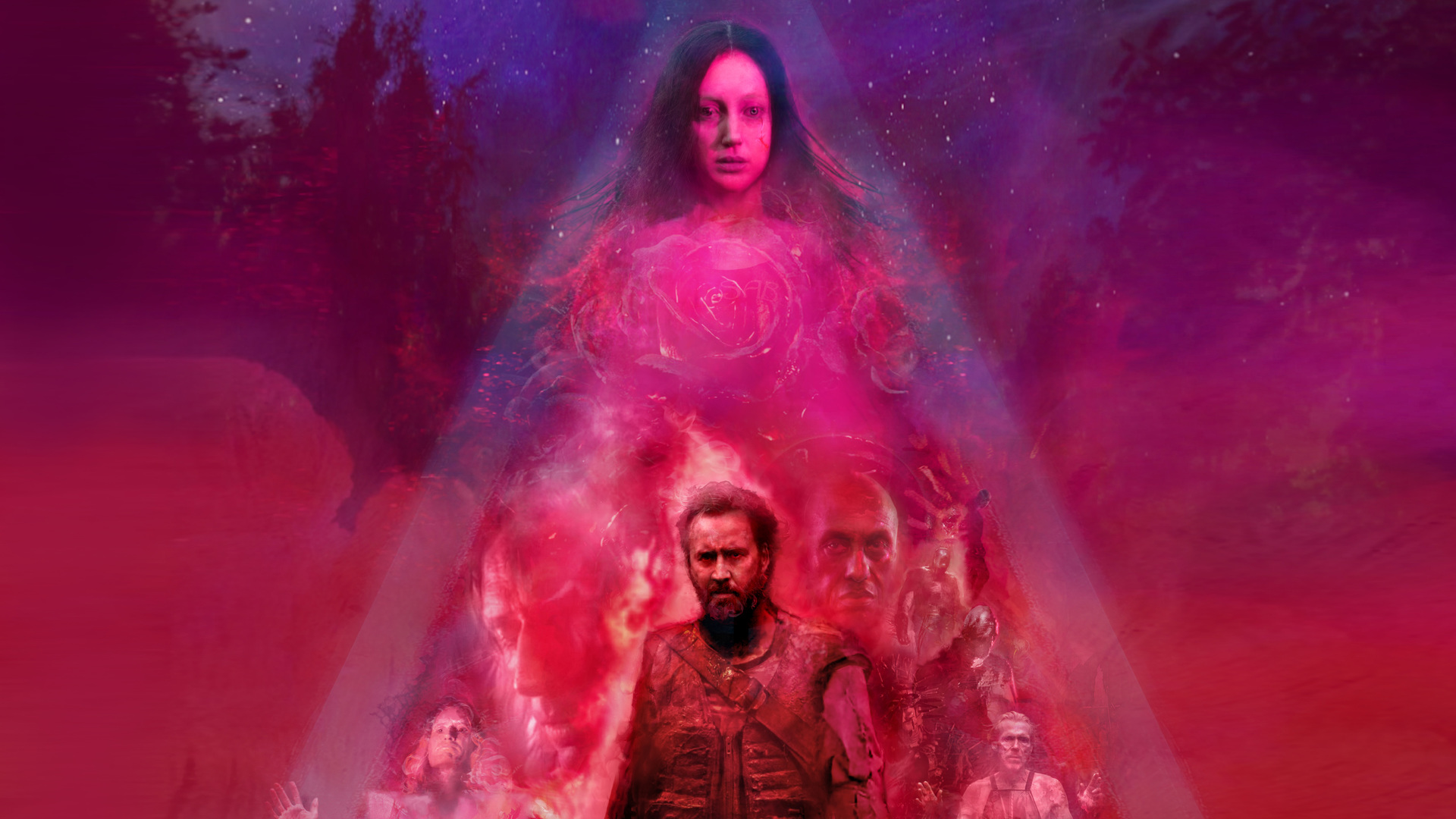I literally just walked out of Mandy. Stumbled out of the darkness of the theater and out into the achromatic, muted thrum of life at large. This movie was bigger than Mother! Bigger than Killing of a Sacred Deer. This thing is cosmologically enormous. And I’m beginning to wonder if Panos Cosmatos has somehow slipped me some his mind altering stimulants that litter his most recent Technicolor nightmare. Could it be that I was stung by an enormous nightmare inducing beetle? And now am I not able to be reintegrated back into the normal flow of life outside his movie? All I know is that something is wrong now. Something seems broken. Either in my brain, or could it be that this movie has made me aware of something that is actually broken in society en masse? Something isn’t right. That much I am sure of. So, shall we begin with The Movie Mandy’s Beginning Middle and Ending Decoded?
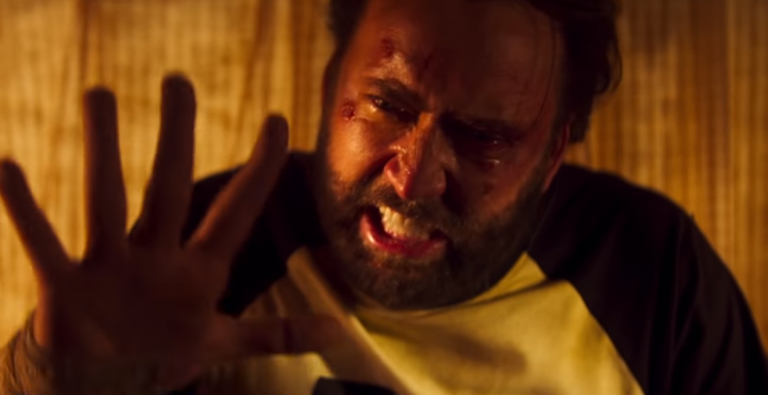
I sort of chuckle at the fact that I am sitting at a keyboard, attempting to explain the soul-schisming experience that is the movie Mandy. To understand this movie, it means moving past the basics of the story, moving past the narrative, and sensing the deeper story that is happening here. Because the narrative? The plot of this movie is about as basic a Hollywood storyline as it gets. I could probably name 10 similar movies to Mandy without pause, and without slowing down. And if you and I were brainstorming together? Fifty would be highly doable if we were given, maybe, what? Ten minutes? But seriously, this movie’s narrative is so simple so as to be summarized, in a single line:
A cult and their leader, kills Red’s wife, and with horrifying vengeance, Red systematically hunts and kills every last one.
There is nothing else. Maybe a few sensational details more. But generally that’s it. And as such, there is literally no way that I can spoil this story because this thing is way more than the basic sum of its parts. I couldn’t do the details of this story justice, even though I will do my best to try. And yet, it’s impossible. Why? Because like a seven layer cake, there is way more here than the icing. Right? There is so much else going on here. Literally has to be. We know this mainly because the movie is so – so – so what? Ephemeral? Visceral? Ultimately epiphanic? This movie is need of its own new adjective to describe it… maybe, Epiphanemeral? Visceralgasmic? (As an aside, I love how the German language has the ability to create mammutwörters. Somehow, I think I was born in the wrong country.)
But even so, you should really watch this movie before you jump in here. But beware, this movie isn’t for anyone. The violence here is an eleven on the official Tarantino-Richter-ScaleTM. (Which isn’t a thing, but I think we should make it a thing… starting today.) Just violence on top of violence. It’s a violence marinade. Blood poured out on top of blood. Pain laid out on top of pain. And yet, despite of its putrefying goriness, it is unreal. (Which begins to hint, just barely, at the very first layer below the surface.) So yeah, this movie really should come with like 19 different trigger warnings. It’s unreal. Here, watch this and you’ll get a feel for what I’m talking about.
Hahahaha… I just saw this comment in the thread for this trailer, “When Nicolas Cage is the sanest person in a movie, you know it’s going to get interesting.” Too true. So yeah, please don’t walk into this movie because I told you to. Haven’t watched it yet, and want to? You can watch it right here:
Mandy Unpacked and Detailed
The opening third of the movie sets the stage for Red Miller’s (Nicolas Cage who’s greatest film (which could be the greatest movie of all time) definitely was Raising Arizona, and no, we aren’t discussing this. This is fact.) relationship with Mandy Bloom (Andrea Riseborough, Birdman, Oblivion, etc.) and the perfectness of their love. There is one scene when Mandy walks out from the water, and we begin to get a hint that there might be something else going on here. Why? Did you see how the camera dropped into slow motion as she walked out of the lake to stand close to the fire? It’s almost as if Panos Cosmatos, and his cinematographer, Benjamin Loeb, are highlighting Mandy’s god-ness. She is from the land of the nymphs, the land of water and of fire. She is not of this world. That Mandy is a perfection that this world doesn’t deserve. And Red’s love for this woman is the only perfect emotion this world has ever experienced. It’s obviously a budding relationship. They aren’t married (thus the different last names), and they’ve only recently started connecting and hanging out. Mandy gives Red a reprieve from the chaotic daily routine of his lumberjack life. You tracking with me so far?
Then comes the first hints of tragedy for this movie. Mandy finds a dead baby deer in the field. And Mandy is transfixed. How could this be? A dead baby deer? And soon she tells Red the story of her father and the starlings. Her father hates the starlings, and so he talks the children into helping him bludgeon them to death, one by one. Obviously Mandy refuses, and runs off. But what does this signify? Well, have you ever seen a Starling Murmuration?
And if you’ve seen the movie Upstream Color you know that a murmuration is anything but insignificant. The starlings, being birds – especially birds capable of such beautiful patterns and stories in the sky – signify a connection to the sky, and to heaven. So these starlings that her father is killing is seen by her as an abomination. And so we get another hint that Mandy may just be an angel. Or at the very least? A symbol signifying incorruptible perfection. And Red? He’s just you. He’s just me. A guy in love with something so perfect he doesn’t fully grasp what he’s dealing with. (Or maybe he is Mandy… but I’m getting ahead of myself. Just keep reading.)
The Cult and Its Motives
Mandy is walking on the road and she walks past a group of people in a van. And the leader of this cult, Jeremiah Sand (Linus Roache) decides he has to have her. This is pretty easy to understand. Evil, in any form desires purity, in order to blemish is, destroy it, desiccate it. And so he orders his second in command, Brother Swan (Ned Dennehy) to go and fetch her. But he also calls in backup. Jeremiah asks Swan to use the Horn of Abraxas… Yeah, we are going to stop right there. The Horn of WHAT?
I dove deep to try and squirrel out the meaning of Abraxas, and after two hours of reading let me just tell you this… it’s confusing. But basically, Abraxas originally came from Egyptian/Greek/Roman origin (no one really knows.) But ultimately, Abraxas began associating with Gnosticism. And then after that he was considered to be a trickster demon that was constantly dropping spiritual subterfuge on people, making them believe that he was in fact, the one true God. When, in fact, he was not. Now, we can assume that when the horn is blown, Abraxas’ minions are summoned. Oh, also? Maybe Jeremiah Sands is Abraxas? Or, more accurately, he is most likely possessed by Abraxas – as seen by the conversations that he has with himself.
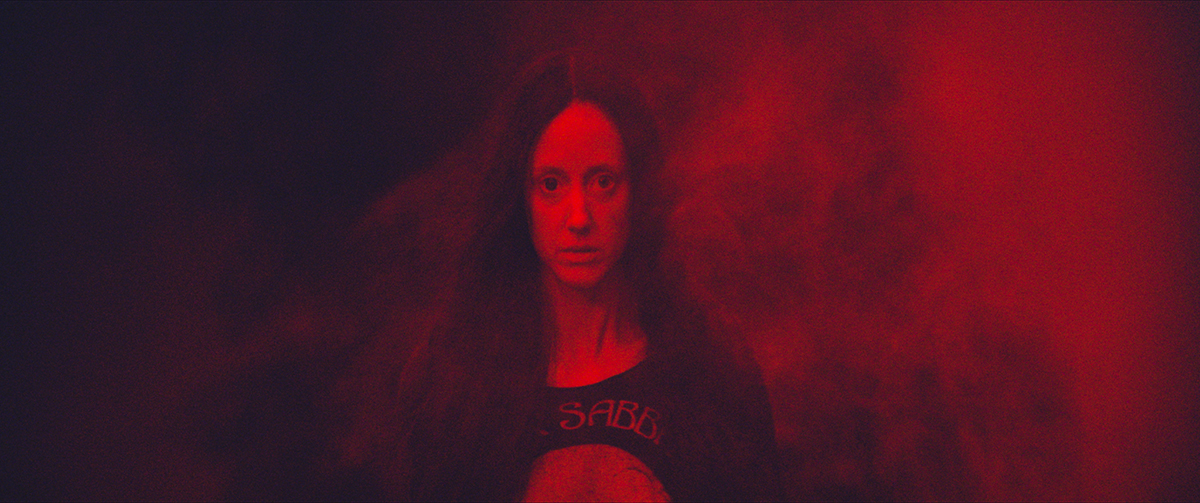
But we also see that blowing the horn has its costs. Jeremiah knows that he is going to have to pay for the blowing of the horn with a life… and he offers Brother Hanker (Alexis Julemont) as payment. A life for a life. A blood covenant. Evil as it is. So when these Hell’s Angels hell spawn deliver Mandy to Jeremiah his goal is to defile her. To destroy her. Well, to prepare her, Mandy is given crazy, mind-tripping drugs, and is stung by a beetle, as the “cherry on the top” of this powerful drug cocktail.
Jeremiah “You called out to me silently on the road, and I listened. What do you see?”
Mandy “I see the reaper fast approaching.”
Jeremiah comes to Red and tells him that he has the ‘tainted blade of the pale knight straight from the abyssal lair.’ Yup, no idea. Basically here’s what I heard when Jeremiah said this, ‘this is the evil blade of the evil demon, that came from his evil home.’ Evil, evil, evil.
Which brings us back to Mandy and Jeremiah’s attempt to consume Mandy. Well, obviously, our perfect goddess isn’t going to allow this, instead she does the one thing she knows will cripple him completely. She laughs at him. And with that, Jeremiah decides she needs to die. So Red, stabbed, and tied up, watches as Mandy is hoisted up (hanged?) and lit on fire. Red is left to watch in horror. (Mandy literally dies at the exact halfway point of the film.) The rest of the film? 100% retribution.
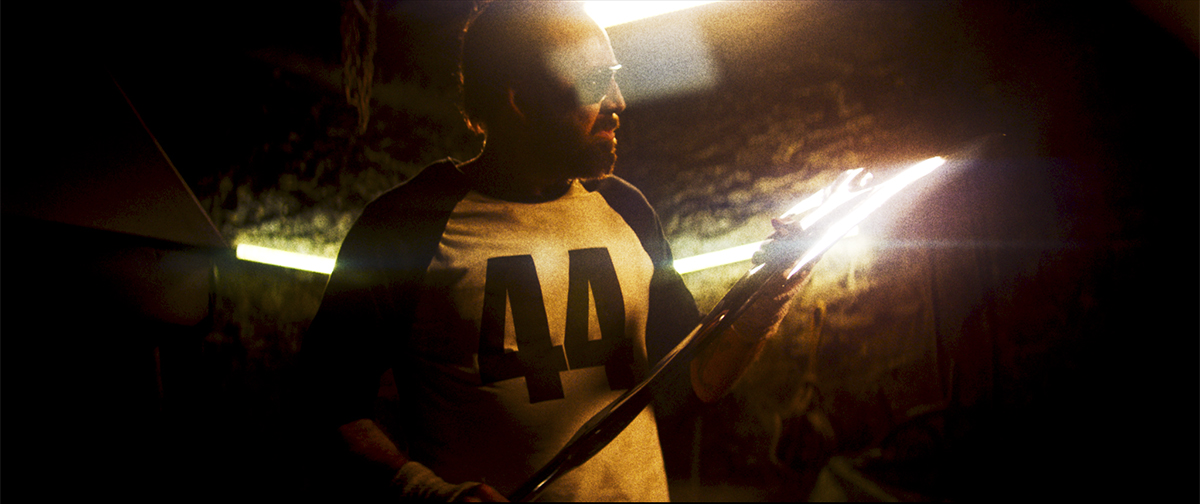
Our Jungian Deep Dive
Ok, I just have to stop us here and call something out. Jung. Carl Jung is what I have to point out here. And if you’ve been through college you know the name well. You know that he was a psychoanalyst that basically crafted/founded the idea of analytical psychology. You also know that he had a deep intellectual relationship with a small figure in that field, Sigmund Freud. The two of them worked diligently together and Freud saw Jung as his future heir of his ideas, and the one person that could carry his studies to the next level.
I hear you saying right now… “Taylor, dude, this movie is all about demons or something. Fine, I got it. But let’s reel back on the Psych 101 stuff!” Trust me. Just give me another paragraph or two, and your Psych 101 self is going to have its mind blown. Because this stuff? Yeah, they don’t teach this stuff in college. Trust me.
Well, in 1908, or the turn of the century, Jung began to see a significant difference between his mentor’s psychology and his own. For one, Jung de-emphasized sexual development and instead began focusing on the collective unconscious… which is the part of the unconscious that consisted of ideas and memories that came from ancestors. The Jungian theories place more emphasis on the spiritual side of our inner psyche than Freud. So, with that, Jung went his own way. About the same time Jung began working on a book entitled the Red Book. And that book? They were a recording of hallucinations he self-induced to try and get to the core of his unconscious. Here’s how Jung himself describes the Septem Sermones ad Mortous (The Seven Sermons of the Dead) began, which was a significant piece of the Red Book.
“It began with a restlessness, but I did not know what it meant or what “they” wanted of me. There was an ominous atmosphere all around me. I had the strange feeling that the air was filled with ghostly entities. Then it was as if my house began to be haunted….Around five o’clock in the afternoon on Sunday the front doorbell began ringing frantically…but there was no one in sight. I was sitting near the doorbell, and not only heard it but saw it moving. We all simply stared at one another. The atmosphere was thick, believe me! Then I knew that something had to happen. The whole house was filled as if there were a crowd present, crammed full of spirits. They were packed deep right up to the door, and the air was so thick it was scarcely possible to breathe. As for myself, I was all a-quiver with the question: “For God’s sake, what in the world is this?” Then they cried out in chorus, “We have come back from Jerusalem where we found not what we sought/’ That is the beginning of the Septem Sermones.” Carl Jung, Memories, Dreams, Reflections, p190-1
Oh, and the chief of these spirits that were crushed up against his door? Yeah, his name was Abraxas. Here, tell me if this passage from his Red Book doesn’t seem familiar after watching the movie…
“The serpent is a whore. She wantoneth with the devil and with evil spirits; a mischievous tyrant and tormentor, ever seducing to evilest company. The white bird is a half-celestial soul of man. He bideth with the Mother, from time to time descending. The bird hath a nature like unto man, and is effective thought. He is chaste and solitary, a messenger of the Mother. He flieth high above earth. He commandeth singleness. He bringeth knowledge from the distant ones who went before and are perfected. He beareth our word above to the Mother. She intercedeth, she warneth, but against the gods she hath no power.” Septem Sermones, Sermo VI
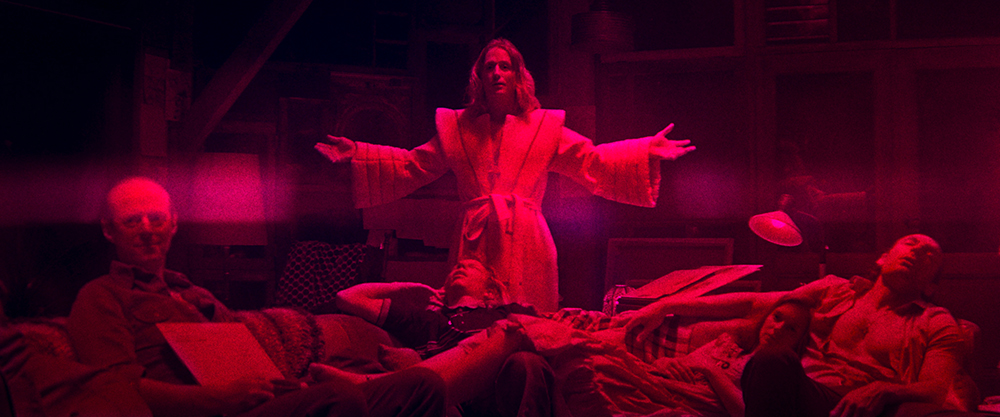
The Conclusion of Mandy Explained
So we have a Jungian demon downward spiral happening here. Don’t believe me? Be my guest and read his Red Book. I’ve already read way more than I should have. I’d currently like those brain cells back. Just trust me. We are watching a cinematic expression of these Jungian ideals. Jung’s deep consciousness. Jung’s demon possessions. Whatever you’d like to call them.
Now, as the movie motors on through to the end we see a few details that are worth noting. The first is that Red doesn’t kill indiscriminately. Instead, he shows mercy on the misguided. Sister Lucy, a pass. And the Chemist, who shows Red that he is surrounded by darkness, a pass. But the rest, all meet their end violently. Culminating in Jeremiah Sands’ death. Which, you should note was literally (non-metaphorically) head crushing orgasm. Like, Red seemed to climax with the ending of Jeremiah’s life. Which, is the opposite of reality. The murder of someone that wronged you would in all actuality cause you guilt and grief. Not euphoria. If thought of practically speaking. But here? Sands’ death sends Red over the edge with giddiness.
But if you watch the ending closely, and I promise you I have… several times now. At the end, as Red flashes back to his first time meeting Mandy, the two of them are wearing his “favorite shirt.” There in the bar, they are both wearing it. Or what appears to be the same shirt. And then immediately after, there in the car, the two of them are wearing the same shirt. And then Mandy is wearing a Led Zeppelin shirt we saw her in earlier… and Red is wearing his bloodied and gnarled clothes. What do we make of this? Is this an indication that Mandy and Red are the same person? Is this some hint that the two of them are different halves of the same personality? Or, better yet is it even bigger than that?
Final Thoughts on the Movie Mandy
No one will ever definitively know what the movie Mandy is all about. Even if Panos Cosmatos comes straight out and tells us, we still won’t know. But he has said in interviews that he wrote Mandy as a method for coping with both his parent’s deaths. So we can know that. But otherwise, it is up to us the reader to ascertain for ourselves where we thought this movie was ultimately going. And to that end, I believe that the Abraxas breadcrumb trail decidedly takes us to the shore of Carl Jung and his fantastical Red Book. We see demons there, we see discussions of spiritual conquests and struggles, we see cosmological insanity galore. Behind one of the paintings within the Red Book we find this quote that may give more explanation than all the rest of this post:
We forged a flashing sword for you, with which you can cut the knot that entangles you…We also place before you the devilish, skillfully twined knot that locks and seals you. Strike, only sharpness will cut through it…Do not hesitate. We need destruction since we ourselves are the entanglement.
So, could it be, that maybe not only was Red, Mandy… but he was also demons he was out to destroy? Could it be, from a Jungian perspective anyway, that this entire movie is one big internal struggle for our hero? That none of it existed outside of his mind and that of his subconscious? Yes, that is what I have been pointing towards since the beginning of this review. Like Jung, this is Panos Cosmatos’ story about his struggle to understand and to grapple with life, and with that of his ancestors dying. It is all about his deep internal thrashing with regard to his consciousness. It is a Jungian internal consciousness battle that wages for his soul and the sanity of his mind.
Post Credits Scene Image Deconstruction
A few of you are pointing out that while I think that I’m on top of this movie, I am in fact, in a word, not. And that is a fair critique, because all of a sudden I am learning that there as a post credit scene that I totally missed?!? Well, thanks to Jay, we have an image from the post credits scene we can dig into… Maybe, eventually, we’ll actually find the actual video. Not that I would encourage you to do anything illegal… but… cough. cough. hahaha.
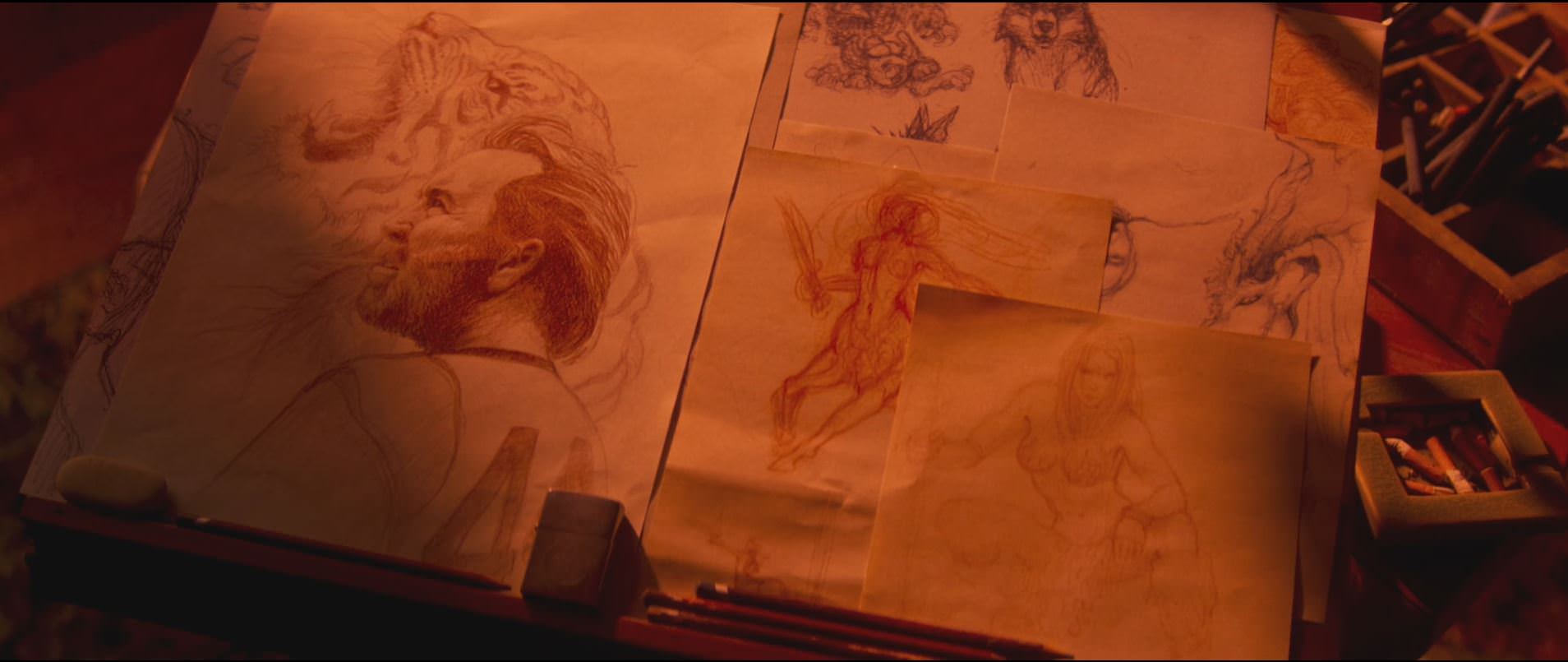
Immediately we know a ton about this screen scrape from earlier in the movie. At the opening of movie, Mandy and Red spend their free time together reading, talking, and Mandy sketches. And Red is on record as thinking her art amazing. And what we see in this still is simple enough in that these are most obviously sketches that Mandy has drawn. And the sketch on the right is of Red. Red and a tiger. And on the right are other mythological creatures, similar to what she was drafting earlier in the film.
What I find fascinating with this still is that it is the first time we have a one to one correlation between Red and the tiger. When I saw the tiger pacing in the cage I wondered if it was an allegorical/metaphorical allusion to Red. But the Chemist released it, and then it’s part in the film was over. Seemed too short to really mean anything. But with this drawing we see a real connection between the two. So what does that mean? That with this struggle, with this inner battle, Red has finally loosed the demons that have tormented him and that he is now free? Interesting. I’ll have to update with more information once I’m able to see the closing scene myself! Sorry for being asleep at the switch everyone.
Anyway, do you have an idea or an opinion of what this mindjob of a movie is all about? Feel free to tell us your take on what Mandy is all about. Because right about now I am thoroughly ready to hear you talk! This movie broke me a bit.
Edited by, CY

